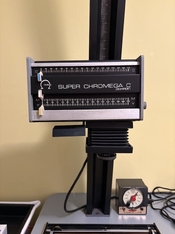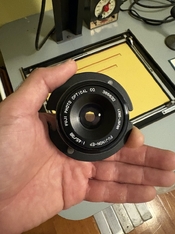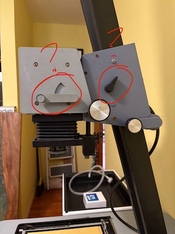Hi folks! I'm new here but I've been making photographs for most of my life.
I was recently gifted an Omega enlarger...the Super Chromega C Dichroic and I need some help with it.
My main issue is with the focusing operation. I have a 35mm negative in the proper negative carrier but in order for the image to come into focus, or rather...anywhere near in-focus, I have to compress the bellows completely. Even with the bellows compressed all the way up, the image is still not in accurate focus. I've never owned an enlarger but have used them in school and have never experienced this issue...where the bellows need to be fully squashed to get the image in-focus. Is there anyone who has experience with this enlarger who can tell me what I'm doing wrong? Was I maybe given the wrong lens with it? Could that be the problem?
My second question: There are four levers or dials on the right side of the enlarger. Aside from the two obvious ones (one raises and lowers the lamp house and one is the focusing knob) I cannot tell what the other two levers are for. There is a grey lever on the side of the lamp house and a black dial on the bracket that holds the lamp house to the tower. (The black dial only makes about 1/8 of a turn.) I cannot tell what the function of either of these is. Does one of these have something to do with my focusing problem? What do they do? I though the black one on the bracket might lock the height of the lamp house but it doesn't seem to do anything.
Lastly, the head of the unit, or the lamp house, wobbles ever so slightly on its mount making it so that the lamp house is not perfectly level. It seems like it may be loose or not attached properly somehow. It doesn't seem like something that should have some wiggle or play in it for such a precise instrument. Is this something I can tighten myself or is this normal?
I will probably mainly be using it for black & white enlargements. Thank you for reading. I would appreciate any advice I can get. I already ordered a paper copy of the manual from KHB Photografix but I'm in Hawaii so it may take a while to get here
Thanks!
I was recently gifted an Omega enlarger...the Super Chromega C Dichroic and I need some help with it.
My main issue is with the focusing operation. I have a 35mm negative in the proper negative carrier but in order for the image to come into focus, or rather...anywhere near in-focus, I have to compress the bellows completely. Even with the bellows compressed all the way up, the image is still not in accurate focus. I've never owned an enlarger but have used them in school and have never experienced this issue...where the bellows need to be fully squashed to get the image in-focus. Is there anyone who has experience with this enlarger who can tell me what I'm doing wrong? Was I maybe given the wrong lens with it? Could that be the problem?
My second question: There are four levers or dials on the right side of the enlarger. Aside from the two obvious ones (one raises and lowers the lamp house and one is the focusing knob) I cannot tell what the other two levers are for. There is a grey lever on the side of the lamp house and a black dial on the bracket that holds the lamp house to the tower. (The black dial only makes about 1/8 of a turn.) I cannot tell what the function of either of these is. Does one of these have something to do with my focusing problem? What do they do? I though the black one on the bracket might lock the height of the lamp house but it doesn't seem to do anything.
Lastly, the head of the unit, or the lamp house, wobbles ever so slightly on its mount making it so that the lamp house is not perfectly level. It seems like it may be loose or not attached properly somehow. It doesn't seem like something that should have some wiggle or play in it for such a precise instrument. Is this something I can tighten myself or is this normal?
I will probably mainly be using it for black & white enlargements. Thank you for reading. I would appreciate any advice I can get. I already ordered a paper copy of the manual from KHB Photografix but I'm in Hawaii so it may take a while to get here
Thanks!





 .
.